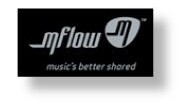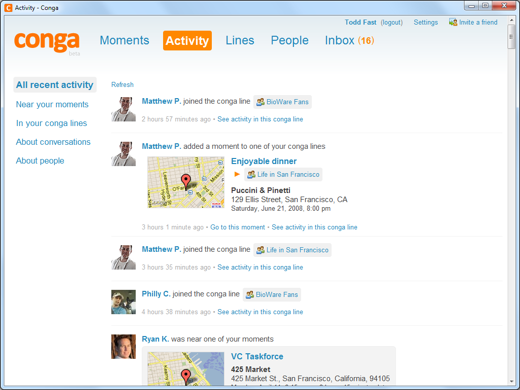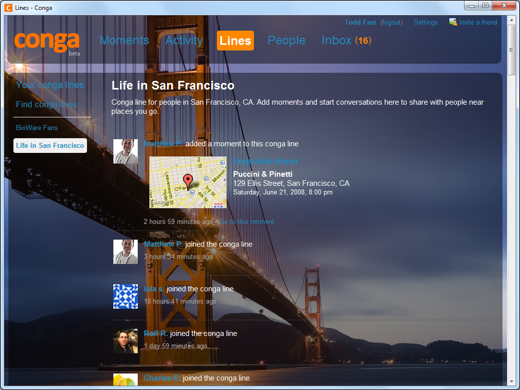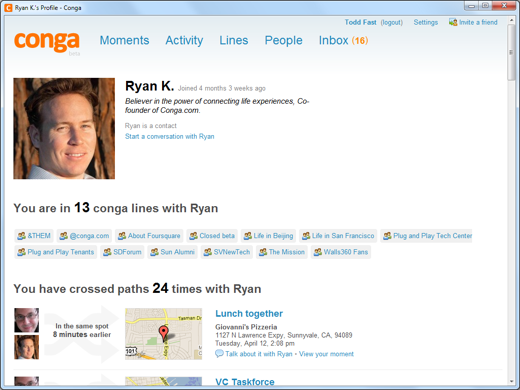
Conga isn’t a location service as much as it’s a way to record moments in your past, present and future and to see which of those moments connect you to other people.
The general concept behind Conga is that people have access to tons of different location services on their computers or phones, but each of those services exists in it’s own ecosystem. If you’re a Foursquare user and a friend uses Facebook Places, there is no way to see that they’ve been in the same place as you in the past, or that they plan on being there in the future.
Ryan Kennedy and Todd Fast of Conga want to bring those disparate services all together in one place to help you connect with other people by seeing where your paths cross rather than living in your own check-in bubble.

In it’s current form Conga is a web service that allows you to connect location sharing services like Foursquare, Twitter and LinkedIn that will feed it with check-ins and ‘Moments’ as you go about your day. Additional services like Facebook Places will be added as they can get them integrated. Once the services are connected to Conga, your check-ins will get automatically added to your personal Moments timeline automatically with a location and your description.
In addition to Moments that are imported from external services you can enter Moments manually for past and future events. If you’re going to attend an upcoming conference for instance. Other people that are attending the same conference would then be able to see that you’re attending and engage you in a conversation about it.
Conga is based on the concept of spatial networking, the idea that connecting with people around the world is good but connecting with people near you is more useful.
The idea that you can use Conga to aggregate locations services all into one place and see how the places that you visit and the things that you do are connected to what other people have done is a fantastic one. It’s solid enough to base the service on alone. But Conga goes beyond just check-ins and connections, allowing you to begin conversations with people based on mutual Moments or by joining Conga Lines that link people to a common topic or interest.
Those conversations can contain a thread of discussion as well as images, video, Powerpoint presentations or just about anything else that you can upload to Conga. This should allow users to view topical and timely media about an event while they’re attending or even after the event. You can’t be there? Simply add a Moment manually and see all of the connections and conversations surrounding the event.
Joining a Conga Line will allow you to share moments and communicate with people that are interested in the same things that you are. Think of them as groups with a theme.
This leads to questions of privacy of course as it does with most location-aware services. The issue is always oversharing because people check in like crazy and sometimes they don’t want people knowing what they were doing there.
Conga has an elegant solution to the problem of oversharing. When you post a Moment the central element is always a location. This is similar to what apps like Path or Instagram do with images. Your location isn’t shared or visible, unless you explicitly choose it to be, until someone else adds a Moment at the same location.
Once they do, they’ll be able to see that you were there and how long ago but other than that your comments are your own. The list of crossed paths on your activity page will include the person’s picture and a link to their basic public profile but that’s it. Everything else that you see pertains to your experiences at that event or place.
You can then choose to view more details about the moment from your perspective or to start a conversation with the person about the event or place, but everything else is privatized unless they accept you as a contact. Even then you can’t view the event from the other persons point of view, their comments, and yours, are always private.
It’s clear after only a short time using Conga that if you don’t use any location services at all you’re probably going to have little personal use for it. If you’d rather pass through life without acknowledging dinners, conferences or events without a check-in then you won’t gain much benefit from using Conga as a personal diary of your Moments. But, even for people who aren’t location junkies, Conga still holds the potential to be a valuable record of events and the conversations and media that are associated with them.
The appeal for a service that collates all of the data from current location services and allows you to discuss that data seems to be relatively wide. Fast is banking on that.
“I would like to see everybody using Conga,” says Fast, “We had the option to narrow [Conga] down to some very specific use cases, like around events or conferences or dating, but what we actually see is the power of having a platform that goes with you throughout all of these cases.”
The plans are to roll out Conga next week in a few major cities to get people using the service and populating it with Moments. A mobile app, profiles that allow for different personas that target casual and professional life and a subscription model are all in the works.
Conga looks like an interesting way to bridge the dozens of popular location services people are using on their mobile devices. Creating a way for users to continue checking in at locations with their preferred services with no interruption then turning to Conga to curate that data into a personal history, pulling location data from anywhere it exists and using it to connect with people and events.
Conga has provided The Next Web with 100 free beta invites if you’d like to check out the service now. Simply click on this link to sign up, first come, first served!
Get the TNW newsletter
Get the most important tech news in your inbox each week.







